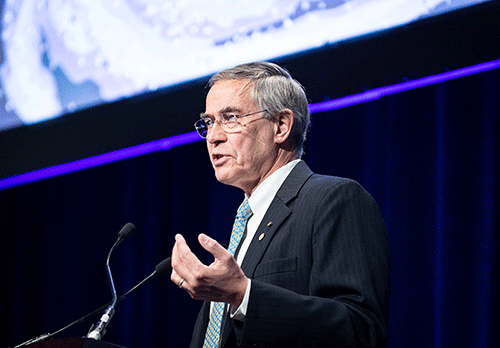Meetings: Scenes from the 2017 APS April Meeting
Defying its name, this year’s “April” Meeting of the American Physical Society kicked off in late January. The conference offered the usual spectrum of talks about particle physics, nuclear physics, and astrophysics—with lots of activity in gravitational waves. But in many of the sessions there was also an undercurrent of concern and speculation about what the new administration in the US would mean for physics research. Here’s a sampling of what we heard at the meeting.
• Scientists need to communicate the message that evidence-based facts are superior to opinions, especially in the current political climate, said physicist Rush Holt, CEO of the American Association for the Advancement of Science. The former Congressman urged physicists to shift from trying to promote “the right answer” to major problems such as climate change and instead focus on communicating “the right process” for solving them. He also encouraged physicists to become involved in politics in some way.
• Black holes were not given much respect by physicists in the late 1960s, recalled Robert Wald of the University of Chicago in his talk on the history of black hole thermodynamics. Wald, who was this year’s recipient of the APS Einstein Prize, said that black holes were seen merely as mathematical curiosities whose existence was unlikely to ever be proven, much like the multiverse today.
• Adinkras are symbols used by the African Ashanti people to decorate pottery and textiles. As he explained in his plenary talk, Jim Gates of the University of Maryland and his colleagues co-opted the term over a decade ago to describe geometric objects that they created to study supersymmetry. Regarding the likelihood of observing supersymmetry in the near future, Gates said experimentalists are just at the beginning of the search, a bit like 18th century American explorers starting a nationwide search for sequoia trees.
• The Sun casts a shadow, at least when you look at the sky in cosmic rays. Mehr Un Nisa of the University of Rochester presented new images from the High-Altitude Water Cherenkov Observatory (HAWC) in central Mexico showing this effect in the high-energy cosmic-ray sky. Earth’s magnetic field deflects lower energy cosmic rays more strongly than higher energy ones, so the shadow position depends on energy. The HAWC team can use this energy dependence to check their detectors’ energy calibrations. The shadow deflection also depends on charge, which could potentially allow the researchers to distinguish antiparticles from particles in future cosmic-ray data.
• The conditions have to be just right for two orbiting black holes to merge within the age of the Universe and thus produce observable gravitational waves, explained Selma de Mink of the University of Amsterdam, who was one of this year’s APS Beller Lectureship winners. A black hole binary system forms from two nearby stars that eventually swell up and later explode in supernovae. The traditional view is that the original stars can’t touch—even in their red supergiant stage—but the post-supernova black holes won't merge unless they are within about 40 solar radii of one another. Mink presented a possible alternative scenario that she and her colleagues studied with numerical simulations, in which a pair of stars touch and never form supergiants.
• Several speakers mentioned that the new US travel restrictions (later suspended) were affecting the ability of their graduate students or colleagues to travel to meetings or to visit family. Carl Rodriguez of MIT showed a new web site on his final slide, one that allows physicists and astronomers to donate to the American Civil Liberties Union to show support for scientists facing these difficulties.
• “There needs to be a route [into science] for a smart kid from Oklahoma or Hyderabad,” said Neil Turok, director of the Perimeter Institute for Theoretical Physics in Canada and recipient of the APS Wheatley Award for promoting physics in third world countries. He discussed the African Institute for Mathematical Sciences, a graduate level, tuition-free, residential university that he founded in his native South Africa in 2003. The program hosts students from all over the African continent, many from extremely poor families, and it now has a network of six centers across Africa.
• February 11th will mark one year since LIGO announced the discovery of gravitational waves. To honor the event, a panel of experts gathered for a discussion. In response to a question, Richard Isaacson, formerly of the National Science Foundation, said that today’s Congress would not risk millions of dollars on a project as risky as LIGO. He also joked that he was the only person in government who had been paid to “throw money into a black hole” by supervising LIGO funding.
• In other LIGO news, more gravitational-wave events may be on their way. Laura Cadonati of Georgia Tech and the LIGO-VIRGO collaboration said in her plenary talk that the observatory has detected two event “candidates” so far in the current observing run, which began November 30, 2016.
–David Ehrenstein





